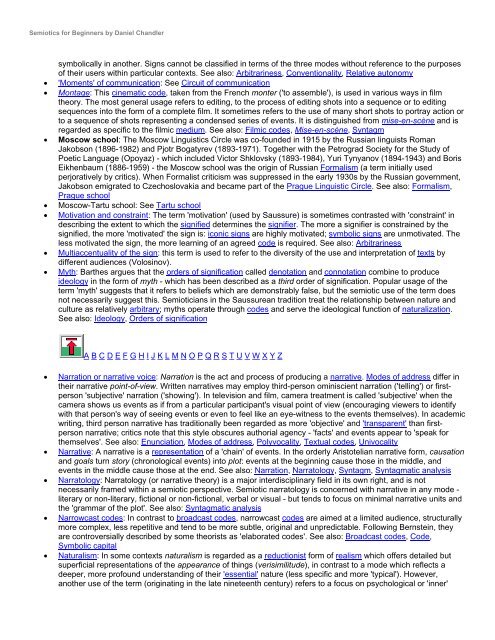Semiotics for Beginners by Daniel Chandler
Semiotics for Beginners by Daniel Chandler
Semiotics for Beginners by Daniel Chandler
Create successful ePaper yourself
Turn your PDF publications into a flip-book with our unique Google optimized e-Paper software.
<strong>Semiotics</strong> <strong>for</strong> <strong>Beginners</strong> <strong>by</strong> <strong>Daniel</strong> <strong>Chandler</strong><br />
symbolically in another. Signs cannot be classified in terms of the three modes without reference to the purposes<br />
of their users within particular contexts. See also: Arbitrariness, Conventionality, Relative autonomy<br />
• 'Moments' of communication: See Circuit of communication<br />
• Montage: This cinematic code, taken from the French monter ('to assemble'), is used in various ways in film<br />
theory. The most general usage refers to editing, to the process of editing shots into a sequence or to editing<br />
sequences into the <strong>for</strong>m of a complete film. It sometimes refers to the use of many short shots to portray action or<br />
to a sequence of shots representing a condensed series of events. It is distinguished from mise-en-scène and is<br />
regarded as specific to the filmic medium. See also: Filmic codes, Mise-en-scène, Syntagm<br />
• Moscow school: The Moscow Linguistics Circle was co-founded in 1915 <strong>by</strong> the Russian linguists Roman<br />
Jakobson (1896-1982) and Pjotr Bogatyrev (1893-1971). Together with the Petrograd Society <strong>for</strong> the Study of<br />
Poetic Language (Opoyaz) - which included Victor Shklovsky (1893-1984), Yuri Tynyanov (1894-1943) and Boris<br />
Eikhenbaum (1886-1959) - the Moscow school was the origin of Russian Formalism (a term initially used<br />
perjoratively <strong>by</strong> critics). When Formalist criticism was suppressed in the early 1930s <strong>by</strong> the Russian government,<br />
Jakobson emigrated to Czechoslovakia and became part of the Prague Linguistic Circle. See also: Formalism,<br />
Prague school<br />
• Moscow-Tartu school: See Tartu school<br />
• Motivation and constraint: The term 'motivation' (used <strong>by</strong> Saussure) is sometimes contrasted with 'constraint' in<br />
describing the extent to which the signified determines the signifier. The more a signifier is constrained <strong>by</strong> the<br />
signified, the more 'motivated' the sign is: iconic signs are highly motivated; symbolic signs are unmotivated. The<br />
less motivated the sign, the more learning of an agreed code is required. See also: Arbitrariness<br />
• Multiaccentuality of the sign: this term is used to refer to the diversity of the use and interpretation of texts <strong>by</strong><br />
different audiences (Volosinov).<br />
• Myth: Barthes argues that the orders of signification called denotation and connotation combine to produce<br />
ideology in the <strong>for</strong>m of myth - which has been described as a third order of signification. Popular usage of the<br />
term 'myth' suggests that it refers to beliefs which are demonstrably false, but the semiotic use of the term does<br />
not necessarily suggest this. Semioticians in the Saussurean tradition treat the relationship between nature and<br />
culture as relatively arbitrary; myths operate through codes and serve the ideological function of naturalization.<br />
See also: Ideology, Orders of signification<br />
A B C D E F G H I J K L M N O P Q R S T U V W X Y Z<br />
• Narration or narrative voice: Narration is the act and process of producing a narrative. Modes of address differ in<br />
their narrative point-of-view. Written narratives may employ third-person ominiscient narration ('telling') or firstperson<br />
'subjective' narration ('showing'). In television and film, camera treatment is called 'subjective' when the<br />
camera shows us events as if from a particular participant's visual point of view (encouraging viewers to identify<br />
with that person's way of seeing events or even to feel like an eye-witness to the events themselves). In academic<br />
writing, third person narrative has traditionally been regarded as more 'objective' and 'transparent' than firstperson<br />
narrative; critics note that this style obscures authorial agency - 'facts' and events appear to 'speak <strong>for</strong><br />
themselves'. See also: Enunciation, Modes of address, Polyvocality, Textual codes, Univocality<br />
• Narrative: A narrative is a representation of a 'chain' of events. In the orderly Aristotelian narrative <strong>for</strong>m, causation<br />
and goals turn story (chronological events) into plot: events at the beginning cause those in the middle, and<br />
events in the middle cause those at the end. See also: Narration, Narratology, Syntagm, Syntagmatic analysis<br />
• Narratology: Narratology (or narrative theory) is a major interdisciplinary field in its own right, and is not<br />
necessarily framed within a semiotic perspective. Semiotic narratology is concerned with narrative in any mode -<br />
literary or non-literary, fictional or non-fictional, verbal or visual - but tends to focus on minimal narrative units and<br />
the 'grammar of the plot'. See also: Syntagmatic analysis<br />
• Narrowcast codes: In contrast to broadcast codes, narrowcast codes are aimed at a limited audience, structurally<br />
more complex, less repetitive and tend to be more subtle, original and unpredictable. Following Bernstein, they<br />
are controversially described <strong>by</strong> some theorists as 'elaborated codes'. See also: Broadcast codes, Code,<br />
Symbolic capital<br />
• Naturalism: In some contexts naturalism is regarded as a reductionist <strong>for</strong>m of realism which offers detailed but<br />
superficial representations of the appearance of things (verisimilitude), in contrast to a mode which reflects a<br />
deeper, more profound understanding of their 'essential' nature (less specific and more 'typical'). However,<br />
another use of the term (originating in the late nineteenth century) refers to a focus on psychological or 'inner'




